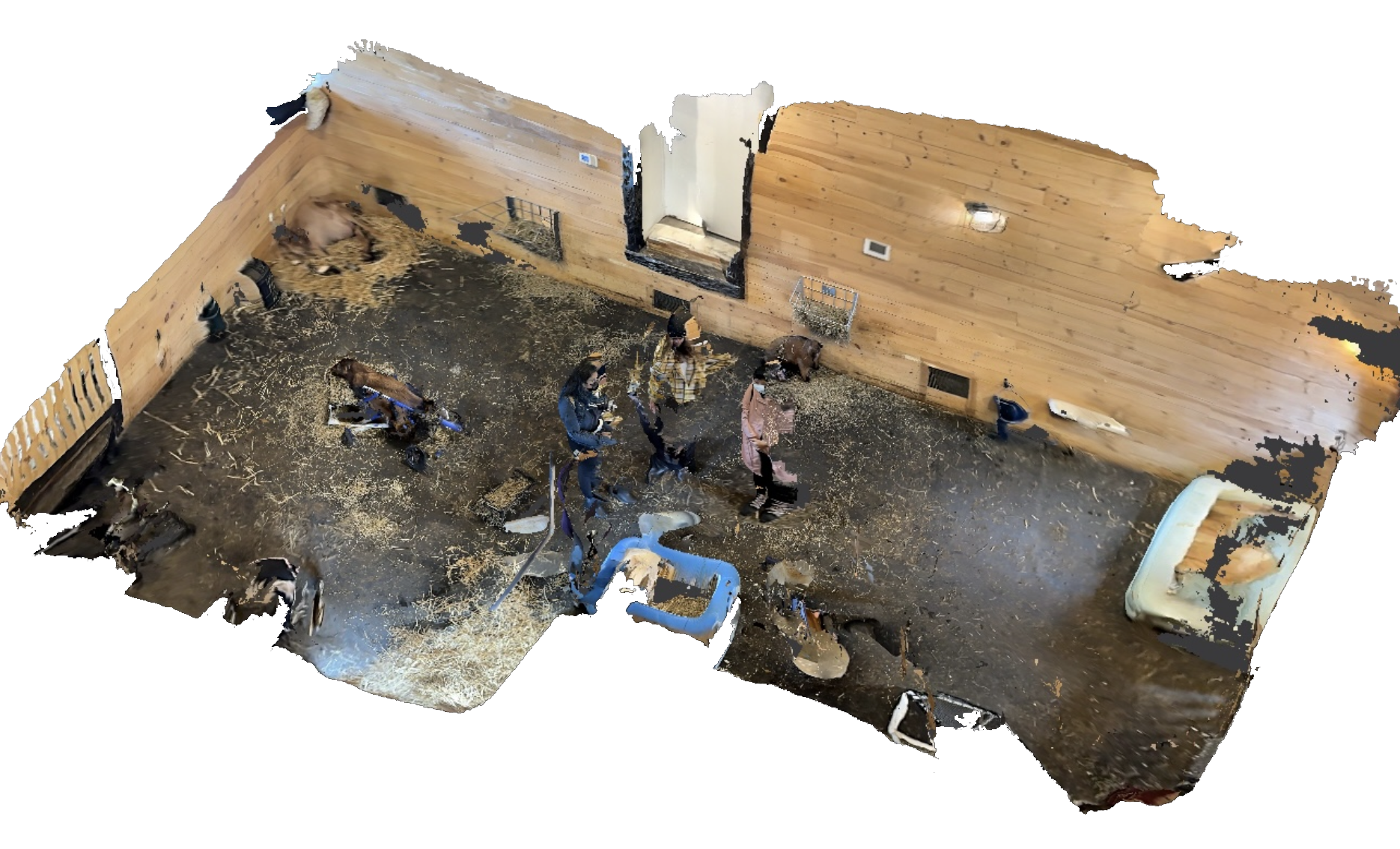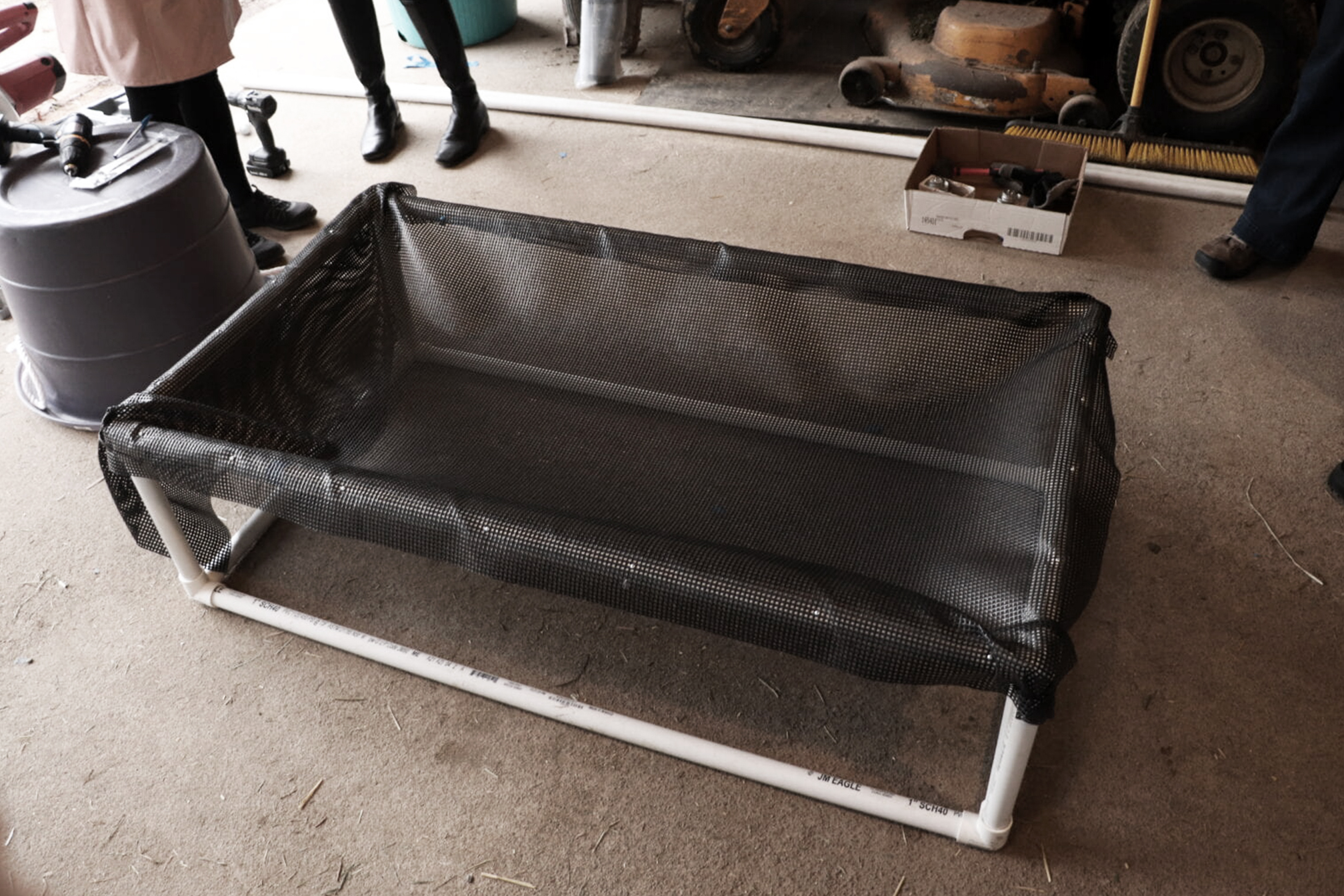
A 3D scan I made during our first visit to Goats of Anarchy
Crib Design for Disabled Goats (2022)
Empowering Animal Care through User-Centered Design and Material InnovationRole:Designer/Product Developer, Researcher
Keywords: Inclusive Design, Animal Well-being, Sustainable Material Research, material research
Community Partner: Goats of Anarchy - an animal sanctuary dedicated to the rescue and rehabilitation of goats with disabilities.

Leanne Lauricella (founder and board president), Prospect, and Lyla (credit: Goats of Anarchy)

Our team “The Cozy Bleats” and Leanne
Problem Statement
- Finn, the largest and heaviest goat on the farm, relies on caretakers for bed access due to his wheelchair.
- He suffers from urine scalds and eye irritation caused by waste accumulation and abrasive crib materials.
- His current setup—a soft inflatable pool bed—provides some comfort but results in pressure sores and irritation from raised seams and material build-up.
Our Goal
- To design a crib for Finn that effectively addresses comfort and hygiene challenges specific to disabled goats.
- We aim to create a lightweight, easily (dis)assemblable, and durable solution that supports Finn’s weight while efficiently filtering out waste.
- Our design aspires to serve as a model that can inspire wider adoption on farms, significantly improving the quality of life for disabled animals.
Our Client - Fin

Finn with his goggles (credit: Goats of Anarchy)

Finn in his soft inflatable pool bed smiling at us
Crib Structure
Crib Structure
Our design for Finn’s crib centered around three key structural elements to enhance Finn’s daily comfort while being easy for caretakers to clean and manage:

Mesh: The mesh must be resilient, affordable, and comfortable, with small openings (less than 1 cm) to prevent Finn’s hooves from getting caught while allowing efficient drainage.
Frames: The bed must be elevated to facilitate effective waste management, ensuring proper drainage and minimizing skin irritation. The lightweight design allows for easy handling by caregivers.
Mesh-to-Frame Attachment: This connection must be secure and efficient to assemble, using options like zip ties, rivets, or screws, ensuring stability without harsh seams that could cause discomfort.
Frames: The bed must be elevated to facilitate effective waste management, ensuring proper drainage and minimizing skin irritation. The lightweight design allows for easy handling by caregivers.
Mesh-to-Frame Attachment: This connection must be secure and efficient to assemble, using options like zip ties, rivets, or screws, ensuring stability without harsh seams that could cause discomfort.
Mesh Material Research

The most important part of the project is the mesh material. We consulted fabric experts, and visited the Material ConneXion and several other fabric stores. We consulted fabric experts and With the list of materials in mind, we conducted a thorough analysis of various materials based on criteria like resilience, drainage, comfort, and cost. Ultimately, we selected trampoline mesh for its durability and excellent drainage properties.
Building Process
Building Process
Throughout the building process, we prioritized Finn’s comfort, safety, and hygiene. Our iterative design approach included thorough material testing, input from animal care specialists, and ongoing trials. We documented each stage, ensuring every adjustment contributed positively to the crib's functionality.

Final Product
The final design features a central dip to prevent Finn from rolling over and falling out, enhancing his safety and comfort. We also created a detailed DIY instructional guide for others interested in replicating the design, promoting accessibility.
The crib's development exemplifies our commitment to animal welfare, and we captured our entire design journey in our group blog, offering insights into our process and the lessons learned along the way. For a comprehensive look at our work, visit The Cozy Bleats Blog.
The crib's development exemplifies our commitment to animal welfare, and we captured our entire design journey in our group blog, offering insights into our process and the lessons learned along the way. For a comprehensive look at our work, visit The Cozy Bleats Blog.

